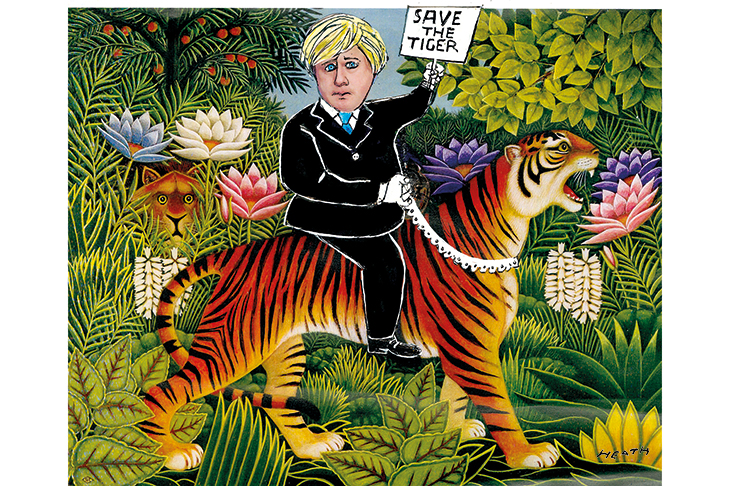I am here in India looking for tigers, and am struck by the way my fellow human beings respond to their encounters —what they want from the whole tiger experience. It is a privilege to see these animals in the wild, and believe me, you can easily fail.
Years ago I spent days tracking them at another park, and though the gamekeepers kept up a plucky commentary — pointing to scratches on trees and snapped grass stems that proved ‘tiger was here’ — we saw neither hide nor hair.
Here at Ranthambore in Rajasthan, however, it is another story. The leaves have yet to return to the axle wood trees; the guides are expert, cocking their ears for the distress call of the chital deer, and people are spotting so many tigers that they are getting quite competitive, in a way that is revealing of our frail human psychology.
It’s all about the ratio of people to beast, and what the punters want is the maximum tiger score to themselves. When one jeep spots a tiger, the word spreads and soon the animal is at the centre of a Hyde Park Corner of 4x4s and charabancs, with cameras sputtering like childish machine-gun fire.
So people always hope for something more exclusive. They want to be alone with the animal, to commune privately, with their eyes locked uniquely on those tiger eyes like giant yellow marbles of liquid fire. They want to boast how they, and they alone, saw the tiger do something special: yawn, scratch, blink, stand up — perhaps even charge — as though its routines were entirely for them.
The result is that even here in Ranthambore, the finest tiger reserve on Earth, the human lust to be exposed to a tiger wildly exceeds the supply; and so I have a question. This is the true king of the beasts, the apex predator at the absolute tippy top of the terrestrial pyramid. Weighing perhaps 550lb, the male Royal Bengal tiger is more than a match for the male African lion (I am afraid they checked), and at 132 decibels its roar is so loud as to cause nearby monkeys fatal heart attacks (your own roar is about 75 decibels).
Since the Mughal emperors, whose pink sandstone pleasure domes and hunting lodges still landmark the park, panthera tigris has been venerated in India, and indeed the whole world is culturally dependent on this universal living metaphor for courage, beauty, aggression and a willingness to defend one’s children no matter how badly they behave. People need tigers more than ever: so why the hell have we allowed the people-tiger ratio to fall into such terrifying decay?
They tell me that in 1900 there were about 100,000 tigers in India. By 1961, when the Queen came to this very park (and the Duke of Edinburgh tactfully declined an invitation to shoot one, citing a ‘whitlow’ on his trigger finger), the numbers were down to 50,000. In the succeeding decades they have been driven relentlessly from their habitat by the tide of humanity.
They have been shot by farmers, they have been poached, their bones ground up for traditional medicines in the Far East, their pizzles pathetically served up — even today — to people who believe this will boost their sexual potency.
We have recklessly allowed the human population to balloon, and we have massacred the tiger, so that the people-tiger ratio is now 7.5 billion to a tragic 3,200. It is an utterly shameful state of affairs. We must change it. I could make all sorts of prudential or anthropocentric arguments for protecting these animals. If we stamp out the trade in tiger parts — as we are now banning the trade in ivory, for which all praise this week to Michael Gove — then we hit the creeps and thugs involved in ancillary trades: drug runners, gun runners, people traffickers. This will be the subject of a major conference in London this October.
If we protect the tiger, we expand the tourist potential in countries blessed with tigers and create tens of thousands of good jobs. If we safeguard the tiger, as my cousin-in-law conservationist Jaisal Singh points out, we must logically safeguard their habitat, which happens to be the source of most of India’s water supply. These reasons are all good, but in the end they are not enough.
This is a moral issue, and a question of how our generation is going to be judged. Since 1972 — in my lifetime — this planet has lost 58 per cent of its mammals, reptiles, birds and fish. The fate of the tiger is echoed across Africa where we have seen catastrophic declines in the numbers of elephants, rhinos, lions, hippos, you name it.
I am not saying that I want the people-tiger ratio reversed, though it might be exciting to be one of the 3,200 people facing 7.5 billion tigers. I’m not even calling for a million tigers. It is about a sense of balance, and fairness to the defeated armies of nature, all the sentient beings that we treat so contemptuously as the ‘also-rans’ of evolution.
Year in, year out, politicians meet to brag about what they are doing — quite rightly — to tackle CO2 emissions, and the targets we attain. It is time to set targets for animal populations. Why not start with a goal of 10,000 tigers in the wild by the end of 2050? If we go on as we are, these animals will have the same status in the minds of our descendants as the unicorn.
Got something to add? Join the discussion and comment below.
Get 10 issues for just $10
Subscribe to The Spectator Australia today for the next 10 magazine issues, plus full online access, for just $10.
You might disagree with half of it, but you’ll enjoy reading all of it. Try your first month for free, then just $2 a week for the remainder of your first year.














Comments
Don't miss out
Join the conversation with other Spectator Australia readers. Subscribe to leave a comment.
SUBSCRIBEAlready a subscriber? Log in